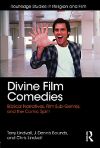- Author(s): Carl Laamanen
- When: 2014-04
- Where: Journal of Religion & Film
Upon its release in 1955, The Night of the Hunter did not find favor among audiences or critics, who failed to appreciate Charles Laughton’s vision for the Davis Grubb’s bestselling novel of the same title. While poor marketing certainly played into the film’s colossal collapse at the box office, I believe there is a deeper reason behind the rejection of the film in the 1950s—its portrayal of women and the female voice. In The Night of the Hunter, Miz Cooper (Lillian Gish) ultimately defeats Harry Powell (Robert Mitchum), the corrupt Preacher, through the use of her voice, and by doing so subverts the dominant patriarchal paradigms of American Christianity and classical cinematic form prevalent in the 1950s. The film gives Miz Cooper the power necessary to overcome the corrupt patriarchy embodied by the Preacher by imbuing her with acousmatic abilities (per Michel Chion) and allowing her control over the cinematic apparatus, sonically and visually. By giving Miz Cooper control over the cinematic apparatus, the film radically breaks with the cinematic, societal, and religious status-quo of the 1950s, accounting for the outrage surrounding the film upon its original release. The reaction to The Night of the Hunter illustrates a larger trend among American Christianity during the 1950s, further illuminating our understanding of how the conservative Evangelical Church of the time thought of women in Church leadership and how it responded to critical representation of its tenets in the culture. While the film brilliantly uses film form and sound to subvert the mores of its time, the adverse reception of The Night of the Hunter reveals that American Christianity and classical cinema were active participants in the oppression of women at the time.








